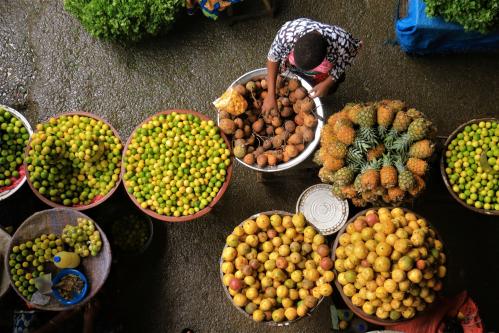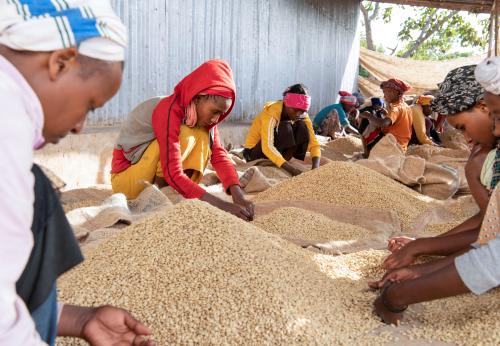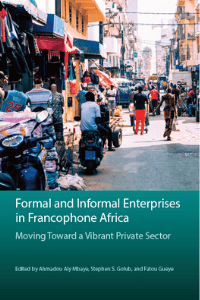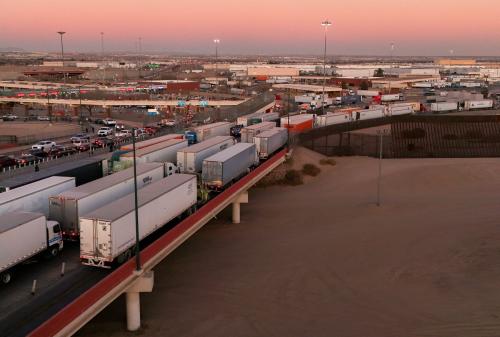Senegal has a lot going for it: Its stable democracy, great irrigation potential, religious tolerance, and proximity to markets in Europe and North America all suggest the West African country is poised to take off. Yet, economic performance since independence in 1960 has been disappointing. In fact, Senegal’s exports have grown much more slowly than global trade and have become increasingly capital-intensive, while its trade deficit has steadily worsened.
To understand this paradox, recent research has focused on the impediments holding back specific industries where Senegal has comparative advantage—fishing and groundnuts, fruits and vegetables, and textiles.
A snapshot of Senegal’s economic growth
In 1960, Senegal’s per capita GDP was about the same as Korea’s, and well above China’s and Botswana’s (Figure 1). Fast-forward to 2015, and Senegal’s per capita GDP is roughly unchanged. Meanwhile, Korea has become a developed country, and China and Botswana have far surpassed Senegal. Consequently, poverty remains pervasive and underemployment in the informal sector is the norm, particularly for women and youth.
What sectors are ripe for Senegal to explore?
The historical evidence is clear that structural transformation and formal employment creation require exports of labor-intensive goods. Our recent research, then, uses the product-space framework to discern export opportunities in Senegal to boost employment, particularly of women and youth, in order to recommend policies to successfully diversify exports into increasingly “complex” products embodying sophisticated capabilities. We adopt an eclectic approach to identifying exports with potential for boosting employment using both the product space and institutional knowledge of the Senegalese economy. We classify exports into three categories: classics, emerging champions, and marginals. Classics are goods that have long been exported; emerging champions are small but rising exports; and marginals are declining exports.
Classics: Fishing and groundnuts
Fishing. Senegal has some of the richest fishing grounds in the world, and the industry already plays a central socioeconomic role there. Importantly, the sector not only generates a large number of jobs directly, but also creates opportunities indirectly, through opportunities in fish processing and distribution, both of which primarily employ women. Despite this potential, fishing in Senegal is under threat: Fish stocks are dwindling due to the joint effects of climate change and overfishing. Dysfunctional government agencies fail to enforce restrictions on overfishing. The government also fails to assist fish-processing firms to meet demanding quality and sanitary norms in European markets. Institutional failure is also seen in a highly cartelized domestic transportation system, which further increases logistic costs and delays. Finally, a lack of appropriate cold storage facilities and poor road quality further compound the sector’s vulnerability, especially since nonfrozen fish do not remain fresh over extended transportation times. Any policies aimed at boosting the sector, then, should start by removing these hurdles.
Groundnuts and groundnut oil. Groundnuts (peanuts) and groundnut oil have been Senegal’s signature products since the colonial era. Notably, green (unprocessed) groundnuts can be much more lucrative than groundnut oil if they are of high quality and meet demanding sanitary and phytosanitary norms in European markets. However, Senegal’s confectionery groundnuts have been barred from foreign markets because of contamination with aflatoxin, a cancer-causing mold that grows on peanuts when they are not cultivated, stored, and transported under proper climate-controlled conditions. The aflatoxin problem is solvable with investments in storage and transport infrastructure and adoption of better technologies in the confectionery groundnut value chain.
Emerging champions: Fruits and vegetables
A favorable geographic location and climate to grow fresh produce all year underpin Senegal’s significant potential to boost fruit and vegetable exports to Europe. However, despite gradual progress, exports remain small. As in the case of groundnuts and fish, stringent quality norms in Europe, along with access to land and water, are major challenges facing the industry. Foreign investment has played a salutary role in opening up market access for Senegalese fruits and vegetables, but extension services and infrastructure must also be improved.
Marginals: Textile and clothing
Clothing and textiles have been the stepping stone to industrial development since the Industrial Revolution. Senegal had a well-developed formal industry inherited from the colonial era and a tradition of skilled informal tailors. However, the collapse of its overly protected and highly ineffective industrial base was triggered by increased smuggling and trade liberalization of the 1980s. Now, Senegal is unable to attract investment and outsourcing from global retail chains looking for new manufacturing hubs due to weaknesses in the investment climate and high unit labor costs.
A comparison of export-processing zones (EPZs) in Senegal and Mauritius is revealing: In short, Mauritius’ EPZ thrived while Senegal’s failed to take off for a number of reasons. First, Mauritius’ institutional environment and political commitment were much stronger than Senegal’s. Senegal’s poor infrastructure, failure to deliver incentives promptly, and inability to insulate firms from onerous labor-market regulations and union agitation undermined its EPZ. Mauritius’s success reveals the importance of improving the overall business environment rather than relying on discretionary tax and customs exemptions.
Despite a strong comparative advantage in fishing, groundnuts, horticulture, and clothing, and substantial opportunities to upgrade and diversify within them, these industries face daunting constraints, particularly in meeting quality standards. As noted above, our research finds that the greatest returns for building economic complexity can come from addressing deficient general and sector-specific infrastructure (e.g., roads and cold storage facilities, respectively), failure to provide technical assistance to firms in meeting quality norms, poor enforcement of illegal behavior such as overfishing, and burdensome labor market regulations. Importantly, improving infrastructure and governance would also boost competitiveness of existing firms and attract new foreign and domestic investors.
The Brookings Institution is committed to quality, independence, and impact.
We are supported by a diverse array of funders. In line with our values and policies, each Brookings publication represents the sole views of its author(s).









Commentary
Removing impediments to export-led growth in Senegal: Groundnuts, fishing, textiles, fruits, and vegetables
September 1, 2020